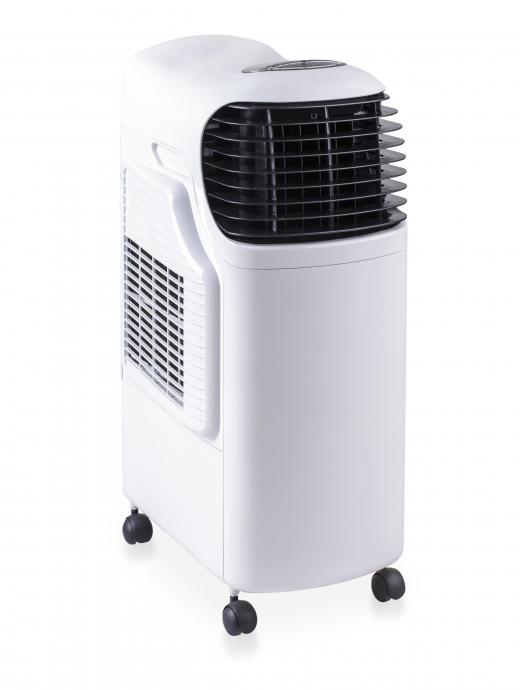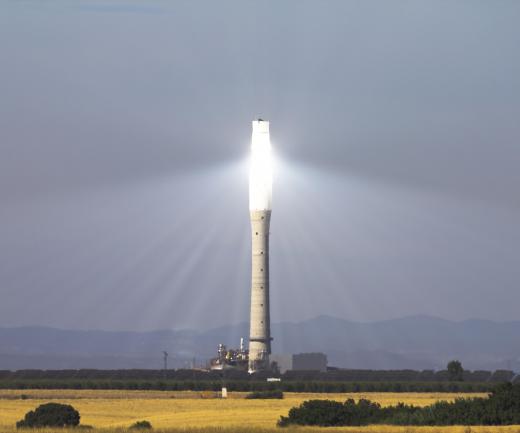What Is Solar Thermal Energy?
 Mary McMahon
Mary McMahon
Solar thermal energy is a form of energy in which the sun is used to produce heat that can be used in a variety of ways. People have been using this energy for thousands of years for a variety of tasks, and modern technology has considerably expanded the applications for the sun's heat. This should not be confused with solar power, in which the sun's light is used to produce electrical energy.
Some of the applications for solar thermal energy are very ancient. For example, solar drying is a technique that uses heat from the sun in food preservation. In this application, food products are laid out on rocks, and the sun's warmth is used to dry them. Evaporation ponds such as those used to concentrate salt also use heat energy from the sun, as can desalination plants.

This form of energy can also be used for cooking, sometimes in very creative ways. Solar ovens use solar thermal energy, and it can be used to heat water to generate steam for cooking. Pasteurization can also be accomplished with the use of concentrated heat from the sun. Another use for it is in the distillation of fluids, and, of course, in hot water heating. Water heated this way can be used for bathing, cleaning, and cooking. It can also be used for home heating; heated water, for example, can be circulated underneath a floor to warm it.

Solar thermal energy can even be used for cooling, although it sounds paradoxical to harness heat to cool things down. In this application, it is used in a process known as evaporative cooling, in which liquid water is evaporated, cooling the air. All of these applications for the sun's heat can be basic to advanced, accessible to people in communities all over the world, including communities in developing nations. Find out the benefits of installing a solar power system in your region.

Heat from the sun can be used in electricity generation. This requires some extensive support technology, but one advantage is that, since heat can be stored, a solar thermal energy plant can operate 24 hours a day to meet power needs. These facilities are typically located in areas that get a lot of sun, so that the maximum amount of heat energy can be harnessed. Towers and reflective arrays of various kinds can be used to collect the sun's heat and concentrate it for the purpose of producing electricity.
AS FEATURED ON:
AS FEATURED ON:














Discussion Comments
I want the list of different months of a year for sunshine duration.
From what I read, solar thermal seems like a big answer to the energy predicament that the world already told. It seems to be much more efficient than photovoltaic solar energy, low maintenance, and on par with the costs of other types of renewable energy generation and different technologies more.
What I have not read about though are some of the major drawbacks of solar thermal energy generation. It seems like energy companies, and supporters of a particular type of energy generation only present the favorable information about their form of energy, while leaving out any disadvantages. It makes me feel like those on all sides of the argument think I am stupid -- like I cannot make a decision while understanding that there is no quick fix to the energy crisis, and every source has its trade-offs. I just want the straight dope.
@ COmparables- Solar thermal energy does have pros and cons, and you listed a few of the major disadvantages. I would like to build off what you said to illustrate on of the pros to solar thermal energy that is often overlooked. Because the solar industry is not fully developed yet, there is still plenty of room for innovation. The reason that you can purchase generators and turbines for fossil fuel plants of the rack is because the industry is mature and has squeezed every ounce of efficiency out of the design as they can. Renewable energy equipment manufacturers would not consider building stockpiles of these supplies since the industry is changing so fast, and gains in efficiency are happening regularly.
@ ValleyFiah- I agree that the lack of an unbiased view only creates more problems when it comes to the energy debate. I can give you the straight dope, and this is coming from someone who is going to school to start a career in Renewable energy. The biggest problem with solar thermal systems, especially through based systems, is water use. Through thermal solar uses more water than any power generation method except nuclear.
The two other glaring disadvantages to thermal solar, and all solar for that matter, is it is not an always on energy source. The amount of energy produced is often dependent on numerous outside factors, making it far from a standalone solution.
Finally, the last major problem with solar thermal energy systems is the initial cost. Capital costs of these newer technologies is much more than those of the rack technologies like those found in coal and natural gas plants. Much of the equipment for these plants is manufactured to order, rather than mass produced, making them more expensive and costly to repair.
From what I read, solar thermal seems like a big answer to the energy predicament that the world seems to be in. It seems to be much more efficient than photovoltaic solar energy, low maintenance, and on par with the costs of other types of renewable energy generation.
What I have not read about though are some of the major drawbacks of solar thermal energy generation. It seems like energy companies, and supporters of a particular type of energy generation only present the favorable information about their form of energy, while leaving out any disadvantages. It makes me feel like those on all sides of the argument think I am stupid...like I cannot make a decision while understanding that there is no quick fix to the energy crisis, and every source has its trade-offs. I just want the straight dope.
Post your comments